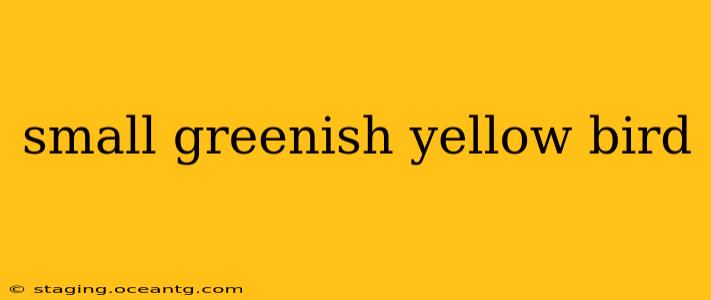Have you spotted a small, greenish-yellow bird and are curious about its identity? Many bird species boast this coloration, making identification a fun but sometimes challenging task. This guide will help you narrow down the possibilities, focusing on key features and geographic location to help you pinpoint your feathered friend. We'll even tackle some common questions people have about these birds.
What are some common small greenish-yellow birds?
This depends heavily on your geographic location! The most common small greenish-yellow birds vary dramatically across continents and even within regions. Some examples include:
- American Goldfinch ( Spinus tristis): A vibrant, small bird with a bright yellow body and black wings, common across North America. Males are more intensely colored than females.
- Yellow Warbler (Setophaga petechia): A bright yellow warbler with chestnut streaks on the breast, found throughout North and Central America.
- Common Yellowthroat (Geothlypis trichas): Known for its distinctive black mask and bright yellow underparts, this species is widespread in North America.
- Various types of Greenlets (Family Vireonidae): These birds, found in the Americas, often show greenish-yellow tones in their plumage, with variations depending on the specific species. Pay close attention to size, shape, and markings.
- Various species of Flycatchers: Several flycatcher species exhibit greenish-yellow hues, often with subtle differences in color intensity and patterns.
What is the best way to identify a small greenish-yellow bird?
Precise identification requires careful observation and consideration of several factors:
- Location: Where did you see the bird? Knowing the region drastically narrows down the possibilities.
- Size: Estimate the bird's size relative to familiar objects (e.g., a hummingbird, sparrow, robin).
- Plumage: Note the exact shade of yellow and green, as well as any other colors present (e.g., black, brown, orange, red). Look for markings, stripes, or spots.
- Behavior: What was the bird doing? Was it foraging on the ground, hopping in trees, or catching insects in the air?
- Song/Call: If you heard the bird's vocalizations, try to describe them or find recordings online for comparison.
How can I use a bird identification app or website?
Many excellent resources are available to assist in identification. Popular options include:
- Merlin Bird ID (Cornell Lab of Ornithology): This app uses a step-by-step process, asking questions about size, location, and appearance to narrow down the choices.
- eBird: This website and app is a great resource for both identifying birds and recording your sightings. It contains an extensive database of bird observations.
- All About Birds (Cornell Lab of Ornithology): This website offers detailed information on various bird species, including photos, sounds, and range maps.
Remember to use high-quality photos or recordings for the best results when using identification tools.
What are some common mistakes in identifying small greenish-yellow birds?
One common mistake is relying solely on color. Many species share similar hues, making color alone insufficient for accurate identification. Paying close attention to size, shape, markings, behavior, and location is crucial for avoiding misidentification. Another common mistake is failing to account for variations in plumage due to age or sex.
What is the range of a [specific greenish-yellow bird, e.g., Yellow Warbler]?
The range of a specific bird will vary greatly. The Yellow Warbler, for example, has a wide range encompassing much of North and Central America. Specific range maps for individual species are readily available on websites like All About Birds or eBird. It's important to consult these resources for accurate range information for the bird you're trying to identify.
By carefully observing the bird and using the resources mentioned above, you'll significantly increase your chances of successfully identifying that small greenish-yellow bird. Happy birding!
